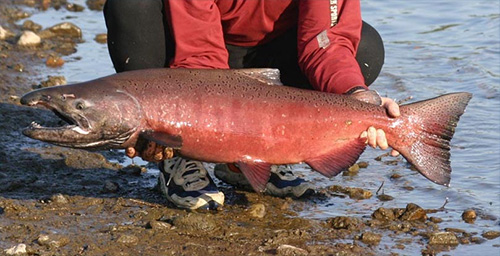
Salmon could win and lose in changing climateBy SONNARY CAMPBELL
October 24, 2017
Researchers from the University of Alaska Fairbanks Institute of Arctic Biology, University of Alaska Anchorage, University of Alaska Southeast, U.S. Geological Survey and the U.S. Fish and Wildlife Service examined patterns of climate, landscapes and fisheries in the past 70 years to help understand where salmon ecosystems may be headed. They focused on the Kenai River in Southcentral Alaska.
Climate and landscape change pose threats to Pacific salmon, especially in lowland streams that can be particularly sensitive to warming and drying, and exposed to concentrated human development. But the future is not all doom and gloom. Other trends are likely to benefit certain salmon populations, such as longer ice-free growing seasons and new lakes that are forming as glaciers retreat. “Salmon are incredibly adaptable, and right now they are facing serious challenges and new opportunities all at the same time. We should expect some surprises in how they respond,” said report lead author Erik R. Schoen, with the Alaska Cooperative Fish and Wildlife Research Unit at IAB in Fairbanks. “Some of the salmon runs that Alaskans have relied on for generations are probably going to decline, but other runs may become more productive. We can’t predict the future, but we can take action now to help mitigate any losses and take advantage of new opportunities.” World-class salmon Alaska salmon support over $1 billion in annual economic output from commercial and recreational fisheries combined. River ecosystems feeding the Gulf of Alaska produce one-third of the world’s wild salmon. Salmon populations and commercial harvests overall are near historic high levels in this region. Salmon provide food, employment, and cultural significance to Alaskans and visitors. The Kenai River embodies the high social value of wild salmon. Changing climate, changing landscapes Alaska has warmed at more than twice the rate of the rest of the United States during the past 60 years. The study region is warming rapidly and experiencing drier summers and wetter falls. Habitats are changing from melting glaciers, drying wetlands, more frequent and intense fires, and increasing human development. In sharp contrast to lowland habitat loss, retreating glaciers are allowing salmon to expand to new habitats in some places. The complex patchwork of landscape changes will likely harm some salmon and salmon habitats, while benefitting others. Many populations are becoming more affected by floods that can kill salmon eggs. Lowland salmon streams are especially vulnerable to warming and drying, and habitat loss from human development. Salmon populations naturally fluctuate tremendously, but landscape and climate change can magnify extremes. Winners and losers The Kenai River lures thousands of anglers annually, despite declines in Chinook salmon. Climate models predict warmer, drier summers and wetter falls. The landscape is changing due to melting glaciers, wildfire, wetland loss and human activities — these changes will undoubtedly lead to winners and losers. Unpredictable salmon runs make fishing an economically risky business. Encouragingly, many factors are under local control, such as protection and restoration of habitat, and coordination among managers and stakeholders. “It’s interesting to look at how landscapes are changing, how humans are affecting change, and think about what that means for salmon and other aquatic species years down the road,” said report co-author Mark Wipfli, USGS research ecologist with the Alaska Cooperative Fish and Wildlife Research Unit at IAB. Opportunities A diversity of options may allow wild salmon and fishing communities to thrive amid the challenges and opportunities posed by climate and landscape change. An important question for communities is whether current policies and land-use patterns sufficiently protect the habitats that are necessary to support resilient salmon runs in a warming world, which could be different from the most productive habitats today. About Alaska fisheries The 2011 USFWS National Survey of Fishing, Hunting, and Wildlife-Associated Recreation - Alaska report found that all fishing-related expenditures in Alaska totaled $639 million in 2011, and trip-related expenditures totaled $528 million. Alaska residents and nonresidents spend $3.4 billion on wildlife recreation in Alaska. One million Alaska residents and non-residents 16 years old and older fished, hunted or watched wildlife in Alaska. Of the total number of participants, 538,000 fished. The paper is authored by Schoen, Wipfli, E. Jamie Trammell of the University of Alaska Anchorage, Daniel J. Rinella of the U.S. Fish and Wildlife Service and 12 others.
On the Web:
Representations of fact and opinions in comments posted are solely those of the individual posters and do not represent the opinions of Sitnews.
|
||||
